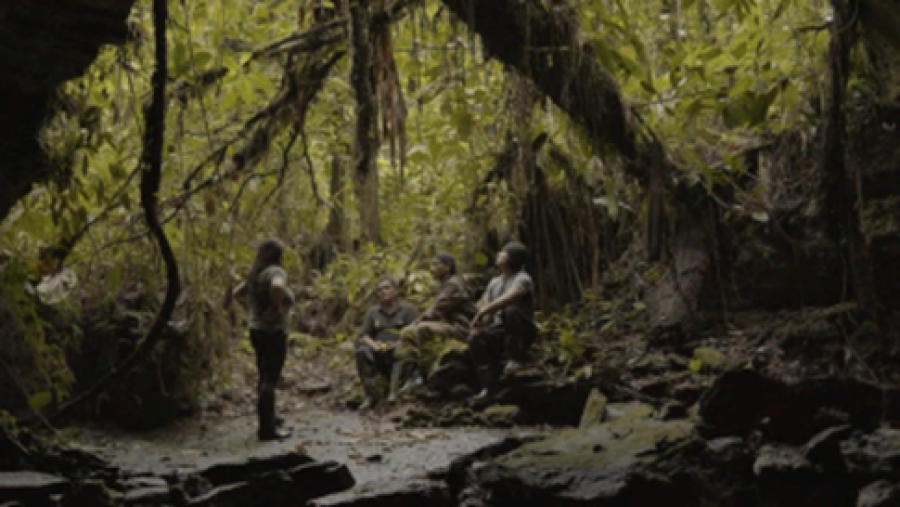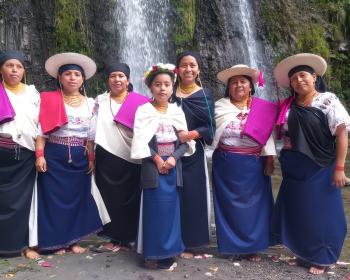Luz María de la Torre Amaguana is an Otovalo Kichwa woman who, in her native Ecuador, is something of a rarity: an Indigenous academician whose research, writing, and teaching are informed by her unique perspective as an Indigenous woman. She earned her master’s degree in political science at FLASCO (Ecuador), and her undergraduate studies were in applied linguistics, specifically bilingual education. She worked at the now-defunct Field Study School in Ecuador of the Program of Latin American Studies at Arizona State University. She also was a docent of Kichwa for Trent University in Canada, taught Indigenous topics at Middlebury Spanish Summer School, and currently teaches at UCLA. She has consulted for UNICEF, UNESCO, the United Nations, and other international organizations; and served in an advisory capacity to Ecuador’s Minister of Exterior Affairs. In addition, she was named president of the National Council of Indigenous Ecuadorian Women.
Her publications run the gamut from bilingual Spanish/Kichwa dictionaries to books nd papers on sociopolitical, economic, and feminist subjects. Each demonstrates her commitment to fight for the advancement, betterment, and sustainable development of a more just society for Indigenous Peoples. I interviewed de la Torre in Ecuador to find out why she has followed this path and what she hopes to accomplish for Indigenous Peoples. Excerpts of that conversation appear here.
Isabel Dulfano: Why are you so proactive within the Indigenous movement?
Luz De la Torre: All Indigenous Peoples have the weight of an exalted history we inherited from our ancestors. But we have lived a difficult situation for many centuries. We have an obligation to inherit the power, as much as the struggle, of our predecessors, in much the same way that we must pass on this legacy to our children.
Listening to important people in the Indigenous movement motivated me to follow this path. Moreover, I believe academia, the university I attended, and my professors put that grain of sand into my palm, creating the need to fight for Indigenous Peoples.
Is your experience typical of other Otavalo women?
No. Thanks to my mother, I had the opportunity to attend school. This prospect did not exist for many little girls in my community. My mother always desired that which she was not able to do herself. She told me: “At least learn to read and write.” I barely even knew Quito. I had been studying at the university in a small town near my home. I was disoriented and unsure, because after graduating high school, my father’s highest aspiration for me was to enter the workforce. For my parents it was sufficient to have completed high school. Then, in 1979, the Catholic University offered a few of us scholarships to study at the Sorbonne in France. Both schools wanted to integrate a group of Indigenous students into their linguistics program. Some of us were also offered work at the same university, where we were employed at the center for Indigenous education.
For the first time, Indigenous intellectuals were involved in thinking about how to construct bilingual education in Ecuador. At that time, several covenants with UNESCO and agreements with Parisian institutions supported the process. This spurred the formation of academic exchange programs for other Indigenous youth. The French embraced us and welcomed us with open arms.
Please explain the meaning of the word “runa.”
“Runa,” in the strict sense of the Kichwa expression, means “human being.” It is used to refer to an Indian. Lamentably, because of colonization and the conquest, we were marginalized and oppressed. This altered the meaning, ultimately making “runa” completely pejorative. Saying the word “runa” for many people who don’t know its real meaning implies a reference to something that serves for nothing, that is opposed to the good. Even today in the markets people use this altered expression. They’ll say they are selling “tela runa” (poor quality material) or “un perro runa” (a defective dog), indicating that it has no worth or, in the case of an animal, that it isn’t pedigreed. This mistaken way of conceiving the term “runa” has been injuring us over the length of our history, because even a non-Indigenous child has the authority to raise an insult with this word and denigrate an Indigenous person, treating us as brutes or unrefined. But we are going to raise ourselves up with the term “runa.” If we take the term in its actual signification of “human being,” a conscious human being that necessarily does not have to be Indigenous, one could identify oneself by this term respectably. Any human being on the planet who achieves a degree of consciousness could be considered a runa, a human being.
You wear traditional dress. What is the significance of that?
Our clothing is very important; it is more than a symbol of our spirit. It characterizes us and has permitted us to be recognized throughout the world. At first, many people felt great shame at wearing these clothes. Yet they are integral to the struggle, a feature of our presence, a means to always be flag bearers of this identity. For the men, the ponchos and hats have signified something else, which in the past, was the focus of our denigration and humiliation. The mestizos would throw our hats on the ground, or snatch them away, dismissing the Indigenous men as inhuman. Now the hat is raised as a standard to say, “Here we are; this is how we are. We are different, and being different we want to live together in this great planetary unity.”
You have promoted and implemented several programs for bilingual education. Can you describe those projects?
Many people have participated in the dialogues on how to educate Indigenous Peoples, how to make them literate. Few understand the immense need that Indigenous Peoples have, which isn’t only to become literate, and or be taught reading, writing, or arithmetic. Bilingual education entails much more. It is a way to erase the racism and discrimination, both internal and external. We live in an era when parents do not associate their language with progress or hope. They don’t see Indigenous language as a tool to get employment, as a tool to free them from the social and economic subjugation under which Indigenous Peoples still live.
The bilingual approach is holistic, drawing on various areas of knowledge, such as anthropology, biology, and language. One class is directed toward creation and dissemination of materials for the teaching of Indigenous languages. In this respect we have made great strides and established links with many nations in Arizona. Through visits to schools of the Navajo and Hopi nations, we have been able to amplify our knowledge just by observing their educational models. The act of re-encountering ourselves as Indigenous is a plus; a virtual fountain of inspiration I drink from when I visit the communities.
In your book La Reciprocidad en el Mundo Andino you articulate a vision for the future, a way of incorporating Indigenous cultural and economic values, based on the Andean legacy.
The Indigenous world contains many elements that can contribute to our appreciation of universal knowledge. From the economic standpoint, many of our own cultural principles lay dormant and unknown. The capitalist point of view prevails today, as if there were no other line of reasoning. The same happens with knowledge systems. In multiple disciplines, the Indigenous world has much to offer. In our book, we mention la minga; it is one strategy that still persists in the Indigenous world as a communal custom for organizing economic relations and realizing work that does not assume money as the intermediary. It also involves more than voluntarism.
Whatever the given task, be it agriculture or pipelines, it takes place through acquiescence. These works dispense with capital as an intermediary and only require the organization of a committed workforce. Our mayors have demonstrated with la minga that they can accomplish public works without economic waste, through a voluntary organization of the people coupled with machinery furnished by the municipality. The result is thousands of projects constructed at the lowest cost.
Likewise for healthcare, Indigenous Peoples contribute valuable knowledge, from drugs to herbal remedies, as an alternative to costly Western health practices. In the realm of education, Indigenous principles again provide alternate models. Thus it is essential to proclaim our capabilities and grasp the extent to which we can contribute. It is greater than the knowledge of the dominant peoples, because we have seen in the midst of the 20th and 21st century the failing of economic, political, and religious systems. Yet Indigenous culture will newly arise after this crisis of centuries to show its efficacy and readiness to contribute.
Isabel Dulfano is an associate professor of Spanish and Latin American Studies at the University of Utah.



